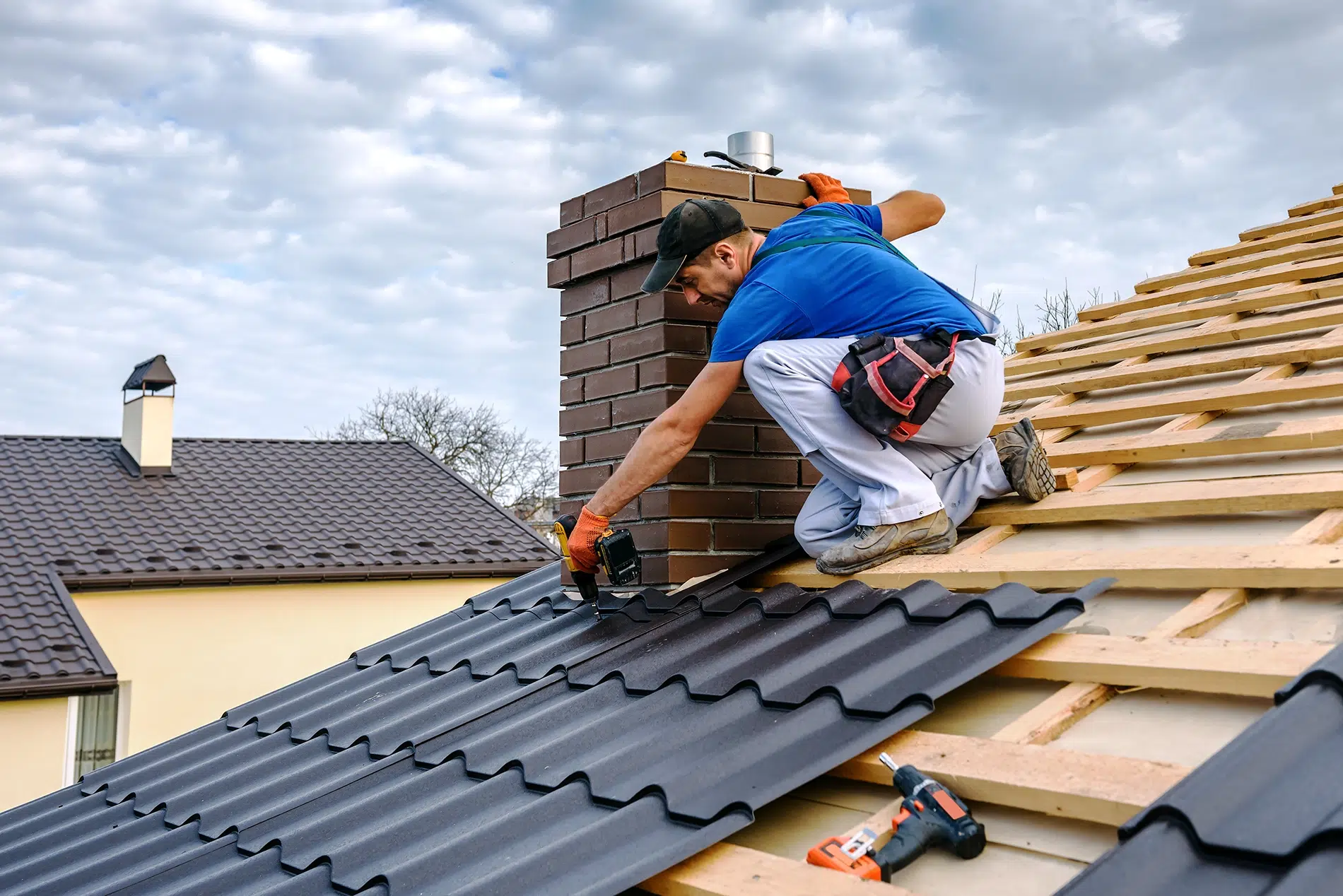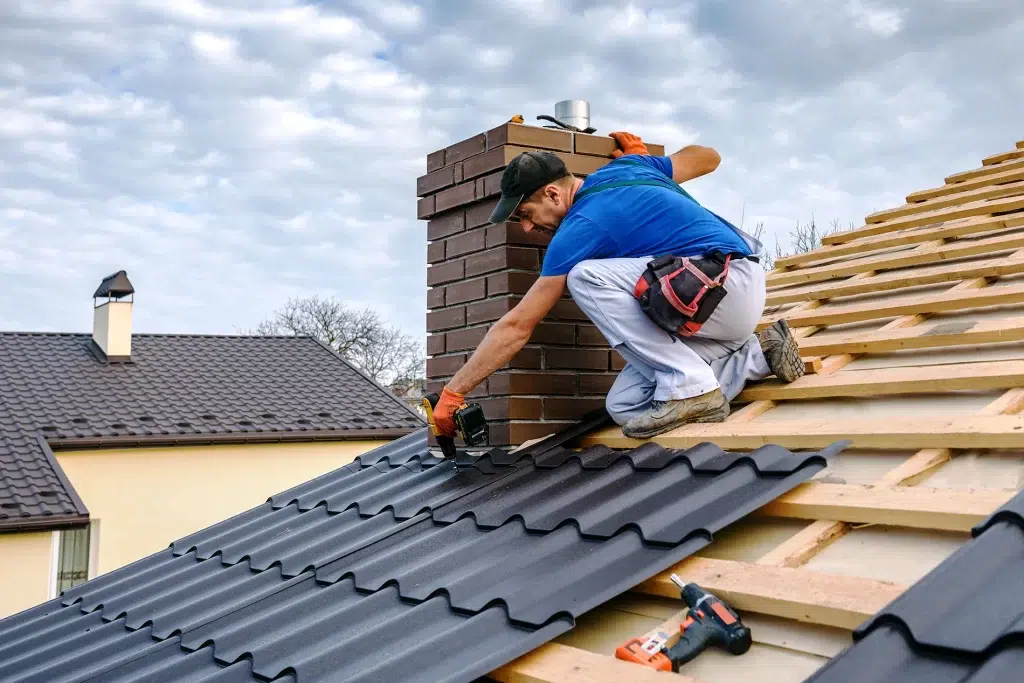Homeowners debating on replacing their roof should give metal roofing strong consideration. It has become more popular among homeowners in recent years with good reason. With a metal roof you can achieve higher durability, increased energy efficiency, and a longer lifespan. Use our guide to determine if metal roofing is right for your home.
What is Metal Roofing?
Metal roofing is roof made from metal sheets, such as steel, aluminum, or copper. It comes in two main styles: standing seam roofs and exposed fastened roofs. Hidden fasteners give standing seam roofs a sleek look. While exposed fastened roofs have visible screws and are usually more affordable.
Pros of Metal Roofing for Your Home
1. Durability and Longevity
Metal roofs are known for their long lifespan—up to 100 years in some cases! They can handle extreme weather conditions like heavy rain, snow, and high winds. This makes metal roofing a solid choice that will last for decades.
2. Energy Efficiency
Metal roofs are excellent at reflecting sunlight, which can help reduce cooling costs in your home. This makes them an energy-efficient choice, especially in hot climates. The reflective surface of metal material keeps your home cooler in the summer. This reflective surface reduces the need for air conditioning.
3. Fire Resistance
One of the key benefits of metal is its fire-resistant properties. Unlike other roofing materials, such as wood or asphalt, metal does not burn. This feature can provide peace of mind, especially if you live in an area prone to wildfires.
4. Environmentally Friendly
Metal roofing is a green choice for homeowners. Manufacturers make many metal materials from recycled materials. These already recycled materials are fully recyclable again. This helps reduce waste and makes metal an eco-friendly option compared to other roofing materials.
Cons of Metal Roofing for Your Home
1. Higher Upfront Costs
The initial cost of a metal roof can be higher than other options. Prices for metal roofs range from $25 to $26 per square foot. For a 1,700-square-foot roof, this can be a significant investment. However, it’s important to consider the long-term savings in maintenance and energy costs.
2. Noise Concerns
Some homeowners worry that metal might be noisy during rain or hail. If not properly insulated, rain can be an issue. However, there are solutions like installing solid sheathing or insulation to reduce noise.
3. Potential for Dents and Scratches
While metal roofs are durable, they can still be dented by hail or falling branches. Some roofing materials are more prone to damage than others. For example, aluminum is softer than steel. Choosing a thicker material or one with a protective coating can help minimize this issue.

Understanding Metal Roof Costs
Roof prices can vary depending on the type of material and the size of your roof. They can also change based on how complex the installation is.
On average, the cost for a metal roof ranges between $25 and $26 per square foot. For a 1,700-square-foot roof, this amounts to approximately $42,500 to $44,200.
The upfront cost is higher than other roofing materials. The long lifespan and low maintenance costs of a metal roof can provide savings over time.
Understanding Metal Roof Costs
Roof prices can vary depending on the type of material and the size of your roof. They can also change based on how complex the installation is.
On average, the cost for a metal roof ranges between $25 and $26 per square foot. For a 1,700-square-foot roof, this amounts to approximately $42,500 to $44,200.
The upfront cost is higher than other roofing materials. The long lifespan and low maintenance costs of a metal roof can provide savings over time.

Types of Metal Roofing Materials
1. Steel Roofing
Steel is one of the most common roofing materials. Steel is strong, durable, and relatively affordable. Steel roofs come in different coatings to protect against rust and corrosion, making them a good choice for many climates.
2. Aluminum Roofing
Aluminum is lightweight, resistant to rust, and ideal for homes in coastal areas. Aluminium is more expensive than steel but is less likely to corrode. This makes it a great option if you live near the ocean.
3. Copper and Zinc Roofing
Copper and zinc are premium roofing options. They are highly durable, can last over 100 years, and develop a unique patina over time. However, these materials come with a higher price tag because of their quality and longevity.
Installation Considerations for Metal Roofing
Installing a roof needs special skills and experience. Choose a professional who knows how to handle specific needs, like proper ventilation and the right fasteners. Standing seam panels are a popular option because they have hidden fasteners, which helps prevent leaks and gives the roof a better look.
Weather Conditions and Roofing Performance
Metal roofs are designed to withstand various weather conditions. They perform well in areas with heavy rain, snow, or extreme temperatures. In hurricane-prone regions, metal is particularly beneficial because of its strength and wind resistance.
Aesthetic Options in Metal Roofing
Metal offers a wide range of colors, finishes, and styles to match any home design. You can choose from different textures and patterns to create a unique look that enhances your home’s curb appeal.
Comparing Metal Roofing to Other Roofing Options
If you’re considering a roof replacement, compare metal with other common roofing materials. Here’s a quick look at the differences:
1. Metal Roofs vs. Asphalt Shingles
Asphalt shingles are the most popular roofing material because they are affordable and easy to install. However, they usually last about 20-30 years. Asphalt lasts significantly less than a metal roof’s lifespan of up to 100 years. Metal roofs are more expensive upfront but offer better durability, energy efficiency, and minimal maintenance.
2. Metal Roofs vs. Tile Roofing
Tile roofing, made from clay or concrete, is known for its durability and aesthetic appeal. However, tile roofs are heavy and may require additional structural support, which can increase installation costs. Metal roofs, while still durable, are much lighter and easier to install. This makes them a versatile option for many homes.
3. Metal Roofs vs. Wood Shingles or Shakes
Wood shingles or shakes give a natural, rustic look but need regular maintenance to avoid rot, mold, and insect damage. Metal roofs resist these problems and offer better protection in wildfire-prone areas because of their fire-resistant qualities.
4. Metal Roofs vs. Slate Roofing
Slate is a premium roofing material that can last over 100 years and offers a unique, high-end appearance. However, slate is incredibly heavy and costly to install. Metal roofing can provide a similar aesthetic at a lower weight and cost. This versatility makes a more practical choice for many homeowners.
Conclusion
Metal roofing offers many benefits, such as durability, energy efficiency, and fire resistance. However, it also comes with some drawbacks, like higher upfront costs and potential noise. By weighing these pros and cons, you can decide if metal is the right choice for your home. If you are considering metal, it’s always best to consult with a professional.


